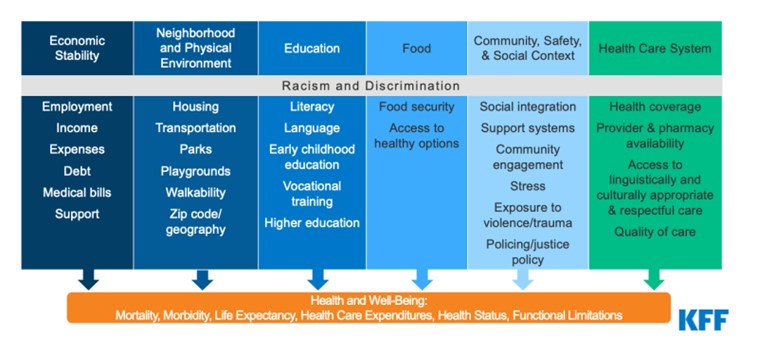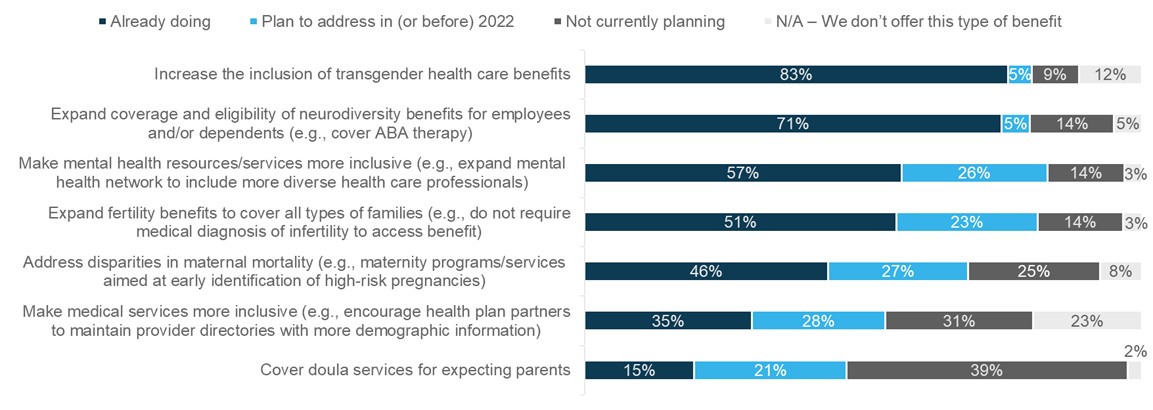February 20 is World Day of Social Justice. The United Nations sponsors this event to address the gross inequalities that exist both within and across countries. By removing barriers that people face because of gender, age, race, ethnicity, religion, culture or disability, the world is better positioned to work together to advance social justice.1
There are many disparities driving health inequities that impact the health and well-being of employees (Figure 1). The past 2 years have exacerbated inequities that employees face. As employers try to overcome inequities within their workplaces, Business Group on Health has developed resources to address challenges within employee benefits and well-being. In a 2021 Business Group on Health survey, almost half of responding employers have integrated diversity, equity and inclusion (DEI) priorities into their health and well-being strategy, and another 35% plan to address them.2

Source: Kaiser Family Foundation. Disparities in Health and Health Care: 5 Key Questions and Answers. May 2021.
Employers are adapting their benefit offerings to be more inclusive (Figure 2). Much work has already been done to meet the health needs of transgender and neurodiverse populations, and now companies are planning to focus on mental health needs, fertility benefits and maternal mortality disparities. They are also striving to ensure that their medical services network is inclusive.2 Given that data drive initiatives, most companies are using employee surveys predominantly and utilizing external sources (e.g., Census, CDC) and claims data to provide a full picture.2
When looking at inequities globally, employers find gaps in medical, family-forming and risk benefit (i.e., life and disability) coverage typically offered in their headquarters country.3 Employers must educate their senior leadership about these gaps and engage with external partners to find innovative solutions (e.g., captives) to coverage where legally possible.3

Source: Quick Survey Findings: Equity, Diversity and Inclusion in Employer-Sponsored Health and Well-being Initiatives. March 2021.
- Develop a global consistency strategy to incorporate and implement standards that are important to your organization.3
- Assess current and prospective benefits (e.g., medical, mental health, family, risk) to identify minority group gaps in accessibility, participation, employee experience, outcomes and cultural consciousness. This assessment should include pinpointing gaps in benefits that would support minority employees.4
- Gain input and feedback from employees about their health and well-being needs, along with changes they would like to see to the benefit portfolio.4 Partnering with employee resource groups (ERGs) can be key to these efforts.4
- Require current and future vendor partners to meet diversity, equity and inclusion standards.4
- Offer an emergency relief fund and/or no- or low-interest loans.4
- Provide student loan repayment and other educational assistance, such as tuition assistance and scholarships for employees or dependents.4
Business Group on Health members have access to several resources to help address inequities in their benefits and well-being offerings including:
- Social Determinants of Health: Addressing Racism
- Ending Disparities in Maternal Mortality
- Family Benefits Bundle
- LGBTQ+ Inclusive Benefits and Employer Challenges
- Global Consistency Strategy Quick Survey Report
References
- 1 | United Nations. World Day of Social Justice. 2020. https://www.un.org/en/observances/social-justice-day. Accessed January 3, 2022.
- 2 | Business Group on Health. Quick Survey Findings: Equity, Diversity and Inclusion in Employer-Sponsored Health and Well-being Initiatives. March 2021. https://www.businessgrouphealth.org/resources/quick-survey-findings-equity-diversity-and-inclusion-in-employer-sponsored-health-and-well-being. Accessed January 10, 2022.
- 3 | Business Group on Health. Quick Survey Findings: Global Consistency Strategy. November 17, 2021. https://www.businessgrouphealth.org/resources/quick-survey-findings-global-consistency-strategy. Accessed January 3, 2022.
- 4 | Business Group on Health. Social Determinants of Health: Addressing Racism. June 15, 2021. https://www.businessgrouphealth.org/resources/social-determinants-racism. Accessed January 3, 2022.
